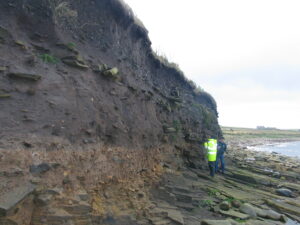
One of the most common calls I get is about coastal erosion. Orkney, indeed Scotland, is known for its archaeology. It is not surprising, therefore, given the length of the coastline, and high energy content of the surrounding seas, that the remains of ancient sites are to be found, dropping out of the cliffs and sand dunes around the coast.
It is a distressing occurrence. Every wall that collapses; every midden that crumbles; every hearth that disappears: they all represent the loss of information about our common human past. You would be forgiven for thinking that it should be a simple task to record and document them all. As with so much in life, however, it is rarely that easy.
The investment of time required to record eroding archaeology is considerable. Professional archaeologists have little spare time, and prefer to spend it on the other elements of life (shopping, relaxing, gardening, you know the score). Archaeological employers are rarely prepared to pay people to focus on generic ‘good works’. Citizen archaeologists can play a fantastic role, especially those who follow a daily walking routine, perhaps along a particular stretch of coast. But they need advice, supervision, support. And they have to be dedicated: the sea will not hold back just because you have gone on holiday, or it is raining. There are places around the UK where eroding sites are noted, and there are organisations prepared to help. There is a lot of good work going on. But it is a never-ending task and has yet to be comprehensive.
The problem is that once you have recorded the eroding face of a site, you are merely waiting for it to collapse once more before you have to start again. Behind the section of every eroding wall or midden lies the rest of the site: vulnerable to the elements as soon as the face of the shore is cut back. There is no doubt that many eroding sites merit full scale excavation. And equally no doubt that, given the cost of any archaeological excavation, finance for this will never be forthcoming. There is no developer to pay for the project where coastal erosion is concerned; the fragile sites here become the responsibility of the local council or national heritage authority. Neither have adequate funding to tackle excavation and all the associated analysis of every, or even some, of the coastal sites in their area.
There is, undoubtedly, more work that could be done. Funded analysis of the coastline would allow us to target stretches that are more vulnerable to erosion and improve management by prioritising recording towards those sites that are more in danger of loss. Local people could be encouraged to take responsibility for monitoring and recording erosion as it happens. In Scotland, the excellent Scape Trust provides a variety of resources and training to support those who are enthusiastic about walking the coast on a regular basis in order to keep an eye out for archaeological losses. In England, the CITiZAN Discovery programme facilitates a variety of recording projects around the coast.
Our coasts are beautiful, and undoubtedly a resource to be treasured. Sadly, they are also fragile, and as such, the source of considerable archaeological loss. Coastal walking is a great way to get in to archaeology and it is undoubtedly rewarding – you won’t have to look far before you spot a site to record. In the absence of unlimited personnel and funds, we can but do our best to make sure that we have a note of every site as it falls in to the sea.
You must be logged in to post a comment.